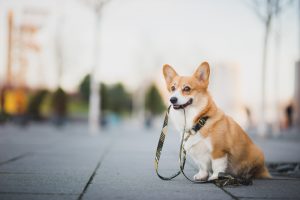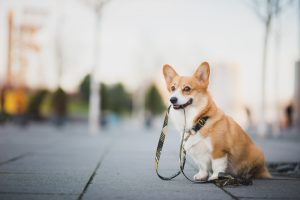
Loose leash walking is a brilliant way for you and your dog to walk together without feeling like there’s a tornado at the other end of the leash. If your dog pulls, lunges, jerks, and jumps, this could be just the training method to make walking with your dog easy and enjoyable.
While loose leash training does take time, you’ll be amazed at how well-behaved and focused your dog is on their walks. It’s such great mental stimulation that your pupper is sure to be completely tired by the time they get back from even a short walk with you or their favourite Dog Walker.
Break out the non-retractable lead and let’s get walking!

What is loose leash walking?
Loose leash walking is exactly what it sounds like. Your dog is going to walk beside you with a loose leash between you. This might seem impossible if your dog tends to pull you through your daily walks.
If there are a lot of doggos in your neighbourhood, you might keep an eye out for examples of loose leash walking. A dog that has had this type of training will walk beside their Owner, though not necessarily right at their heel. And these well-trained pups will periodically look to their Owner for reassurance and maybe even a treat. When they’re not looking at their Owner, they will be looking ahead without pulling away to sniff or explore.
What are the benefits of loose leash training?
The first benefit, of course, is a more enjoyable and controlled walking experience. A dog who has received loose leash training will follow your guidance instead of their own nose.
Because there’s so much focus involved in this type of walking, your dog will get a great mental workout. Instead of being overwhelmed by smells and sounds, they’ll be focused on their task. For this reason, loose leash walking is especially beneficial for working dogs who feel most content when doing a job.
Another benefit of loose leash training is that it can help you control where your pupper goes potty. If you’ve been trying to get them to do their business in a particular spot, loose leash training can help. With this walking technique, you will be in control of when your dog goes potty, stops to smell something and interacts with other dogs and people.
Finally, loose leash walking has the advantage of safety. Without struggling to gain control of your excited dog, you’ll be better able to stay aware of your surroundings. And, because your pup will be more open to listening to you, they’ll respond more quickly to commands that will keep them safe.
With all of these benefits in mind, what do you need to get started?
What supplies do you need?
There are a lot of walking supplies on the market for Dog Owners. No-pull harnesses, retractable leashes, as many different kinds of collars as you can think of. But here are some basic tools that can help with loose leash walking:
- A non-retractable leash of 120cm to 180cm long
- Your choice of: a front clip harness, head collar, or control collar (these provide slight tightening and are much safer than prong or chain collars)
- A pouch full of treats
First steps of loose leash walking
Before you take your pup outside, the first steps of loose leash training will happen right at home. This will ensure that you can give your dog a calm, controlled environment to practice.
Set your pup up with their walking gear and start at one end of the room or hallway. Choose a side that you will have your dog walk on every time, and have your dog sit on that side. Hold the lead in the opposite hand with enough slack for it to droop without dragging on the floor.
Take a single step forward and give your dog a treat. What you want is for your pup to move forward as they see the treat, not because you’ve pulled on the leash. And it’s okay if your dog isn’t glued to your hip; as long as they’ve stepped forward without pulling on the lead, you’re in good shape.
Repeat this process several times. If your dog does start pulling on the leash, you will stop in your tracks and wait until your dog also stops and looks at you. Within two seconds, praise them and give them a treat.
Eventually, you should be able to walk forward several steps with your dog looking to you for treats and without pulling on the leash. This is a good sign that they’re ready to take their loose leash walking training outside.
Keep these training sessions relatively short, about ten minutes to start and no longer than twenty minutes. If you can’t schedule multiple training sessions per day, at least try to do it once daily. This phase could take several sessions before your dog understands what’s expected of them. But stick with it! It will lay a good foundation for walking outside.
Loose leash walking outside
The basics of loose leash training outside are essentially the same as they were inside. But, instead of focusing on how far your walk will be, it’s much more useful to set a time limit. After all, as you start loose leash walking, you will not get far. You might not even make it to the end of the block. But don’t worry, your doggo will still be getting a wonderful opportunity for mental stimulation.
Remember to keep the treats handy and only walk as far as you can while your dog is still engaged and not pulling on the leash. When they pull on the leash, stop and bring them back to you with a command and a treat.
As your dog gets more comfortable with this exercise, you can bring them to areas with more distractions.
Other tips
Once you and your pup start loose leash walking successfully, it will be hard to imagine a time when you felt like you were walking a furry tornado. Make sure the training sticks with these tips:
- Stay consistent. Especially in the early stages of loose leash training, it can be easy to slip back into old habits. After all, the training is monotonous and tiring for dog and trainer, and can take weeks to become a sustained habit. But, staying consistent every time you take your dog on a walk will make sure that loose leash walking is their default.
- Give your dog other exercise outlets. Until you’re able to take your dog for full-length walks with a loose leash, you may want to supplement your dog’s exercise schedule. This will help to burn off some of their energy so that they’re not overly excited during training sessions.
- Keep your Dog Walker in the loop. After loose leash walking has been established in your household, your friendly Dog Walker can help to reinforce the training. Let them know which side your dog walks on and how to reward your dog for good behaviour.
- Schedule in some refresher sessions. Like any training method, loose leash walking can benefit from the occasional refresher session. Every once in a while, reinforce what they’ve learned by going back to step one and focusing on the basics.
Will you try loose leash walking with your dog?
Every Dog Owner dreams of having a perfectly behaved walking companion. And, it would be nice not to worry about your dog being a complete terror when they go out with their Dog Walker!
Whether you’ve tried this method or this is your first time hearing about loose leash walking, we’d love to know whether you think it’s right for your dog!